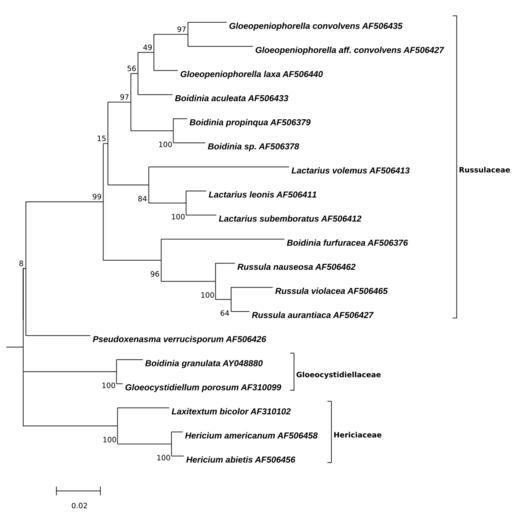MAKE A MEME
View Large Image

| View Original: | Boidinia-Maximum-Likelihood-Tree.svg (129x128) | |||
| Download: | Original | Medium | Small | Thumb |
| Courtesy of: | commons.wikimedia.org | More Like This | ||
| Keywords: Boidinia-Maximum-Likelihood-Tree.svg Figure Figure Molecular Phylogenetic analysis of Boidinia and Gloeopeniophorella by Maximum Likelihood method <br/> The evolutionary history was inferred by using the Maximum Likelihood method based on the Kimura 2-parameter model 1 The tree with the highest log likelihood -4514 2002 is shown The percentage of trees in which the associated taxa clustered together is shown next to the branches A Strict Consensus Maximum-Parsimony tree was used as an initial tree in the heuristic search A discrete Gamma distribution was used to model evolutionary rate differences among sites 5 categories +G parameter 0 5454 The rate variation model allowed for some sites to be evolutionarily invariable +I 59 4678 sites The tree is drawn to scale with branch lengths measured in the number of substitutions per site The analysis involved 19 nucleotide sequences All positions with less than 95 site coverage were eliminated That is fewer than 5 alignment gaps missing data and ambiguous bases were allowed at any position There were a total of 1167 positions in the final dataset Evolutionary analyses were conducted in http //megasoftware net/ MEGA6 2<br/> 1 Kimura M 1980 A simple method for estimating evolutionary rate of base substitutions through comparative studies of nucleotide sequences Journal of Molecular Evolution 16 111-120 <br/> 2 Tamura K Stecher G Peterson D Filipski A and Kumar S 2013 MEGA6 Molecular Evolutionary Genetics Analysis version 6 0 Molecular Biology and Evolution30 2725-2729 <br/> ; List with GenBank Sequences http //www ncbi nlm nih gov/nuccore/AY048880 Boidinia_granulata AY048880 http //www ncbi nlm nih gov/nuccore/AF506379 Boidinia_propinqua AF506379 http //www ncbi nlm nih gov/nuccore/AF506413 Lactarius_volemus AF506413 http //www ncbi nlm nih gov/nuccore/AF506378 Boidinia_sp AF506378 http //www ncbi nlm nih gov/nuccore/AF506433 Boidinia_aculeata AF506433 http //www ncbi nlm nih gov/nuccore/AF506435 Gloeopeniophorella_convolvens AF506435 http //www ncbi nlm nih gov/nuccore/AF506440 Gloeopeniophorella_laxa AF506440 http //www ncbi nlm nih gov/nuccore/AF506462 Russula_nauseosa AF506462 http //www ncbi nlm nih gov/nuccore/AF506376 Boidinia_furfuracea AF506376 http //www ncbi nlm nih gov/nuccore/AF506426 Pseudoxenasma_verrucisporum AF506426 http //www ncbi nlm nih gov/nuccore/AF506458 Hericium_americanum AF506458 http //www ncbi nlm nih gov/nuccore/AF506456 Hericium_abietis AF506456 http //www ncbi nlm nih gov/nuccore/AF310099 Gloeocystidiellum_porosum AF310099 http //www ncbi nlm nih gov/nuccore/AF506411 Lactarius_leonis AF506411 http //www ncbi nlm nih gov/nuccore/AF506465 Russula_violacea AF506465 http //www ncbi nlm nih gov/nuccore/AF506412 Lactarius_subemboratus AF506412 own 2014-09-05 Thkgk Cc-zero Gloeopeniophorella Boidinia Russulaceae | ||||